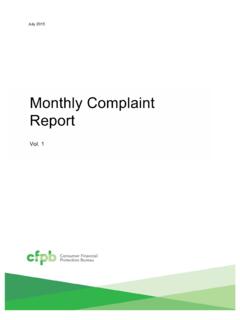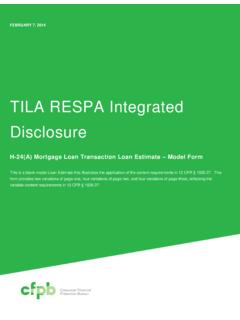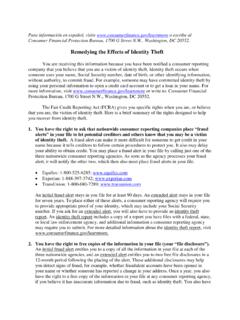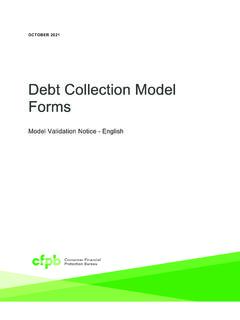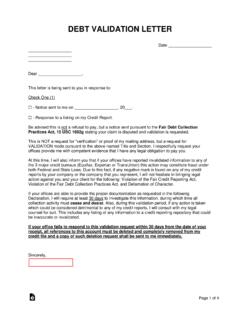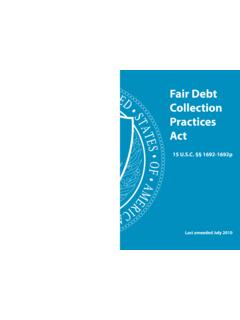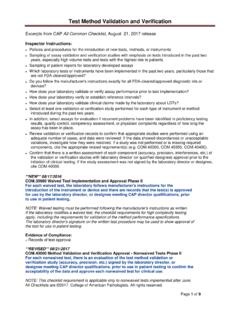Transcription of Debt Collection Rule: Disclosing the Model Validation ...
1 1700 G Street NW, Washington, DC 20552. October 29, 2021. Debt Collection Rule: Disclosing the Model Validation Notice Itemization Table 1. The Debt Collection Rule (Rule) requires debt collectors to provide consumers with certain information to help them identify the debt being collected. This information is called the Validation information and consists of information about the debt, information about the consumer's protections and rights during Collection of the debt, and information to facilitate the consumer's ability to exercise those rights. The Rule details how a debt collector can provide the Validation information in a Validation notice.
2 Appendix B of the Rule sets forth a Model Validation notice that a debt collector has the option to use to provide the Validation information. A debt collector is not required to use the Model Validation notice. However, a debt collector who uses the Model Validation notice obtains a safe harbor for the content and format requirements related to the Validation information. 1 12 CFR. (d)(2); see also 12 CFR (c) and 34(d)(1). A debt collector also has the option to use a version of the Model Validation notice that adds or omits certain optional content, a version that includes certain content on a separate page, or a version that is otherwise substantially similar to the Model Validation notice.
3 A debt collector who This is a Compliance Aid issued by the Consumer Financial Protection Bureau. The Bureau published a Policy Statement on Compliance Aids, available at rules/policy-statement-compliance-aids/, that explains the Bureau's approach to Compliance Aids. 1 An editable version of the Model Validation notice is available here. 1 DEBT Collection RULE: Disclosing THE Validation INFORMATION VERSION (10/2021). ITEMIZATION TABLE. uses one of these options also obtains a safe harbor for the content and format requirements related to the Validation information, except with respect to any content that appears on a separate page.
4 12 CFR (d)(2); see also 12 CFR (c) and 34(d)(1). However, because use of the Model Validation notice is not required, a debt collector also has the option to provide the Validation information using a form that is not substantially similar to the Model Validation notice. Such a Validation notice must still provide all of the required Validation information, and a debt collector who uses such a notice does not receive a safe harbor for the content and format requirements of the Rule for the Validation information provided. 12. CFR (d)(2); see also 12 CFR (c) and 34(d)(1). 2. This guidance document addresses how to provide certain Validation information.
5 This document assumes use of the Model Validation notice. 3 Specifically, the Rule requires debt collectors to include on the Validation notice both the current amount of the debt and certain information about the debt as of a particular date called the itemization date. Most of this required information appears on the Model Validation notice in a tabular format. Because this document assumes use of the Model Validation notice, it also assumes this information will be disclosed in the tabular format. This document refers to that table as the Itemization Table when providing guidance on the included disclosures. However, the concepts discussed also apply more generally even if the Model Validation notice is not used.
6 2 More information about the Validation information content and format requirements can be found in Section 12 of the Debt Collection Rule Small Entity Compliance Guide. Additionally, more information about the option to use the Model Validation notice and how changes to the Model Validation notice affect the safe harbor for the Validation information content and format requirements can be found in the Debt Collection Rule FAQs, Validation Information Questions 2 through 4, as well as Section of the Debt Collection Rule Small Entity Compliance Guide. 3 That is, this guidance document assumes a debt collector will use the Model Validation notice as it appears in Appendix B of the Rule.
7 This generally assumes that, among other things, a debt collector will not disclose certain Itemization Table information on a separate page or use, for residential mortgage debt, the ability to substitute the most recent periodic statement for some Itemization Table information ( , follow the special rule for residential mortgage debt, or Special Rule ). 12 CFR (d)(2)(ii). As noted, a debt collector who uses either such option retains the safe harbor for content and format requirements when using the Model Validation notice, except with respect to content appearing on the separate page. However, some of the guidance discussed below may not apply, or may apply differently, in such cases.
8 For more information on the ability to disclose certain Itemization Table information on a separate page, see footnote 8, below. For more information on the special rule for residential mortgage debt, see footnotes 4 and 7, below and the Debt Collection Rule FAQs, Validation Information: Residential Mortgage Debt Questions. 2 DEBT Collection RULE: Disclosing THE Validation INFORMATION VERSION (10/2021). ITEMIZATION TABLE. This guidance document first provides an overview of the Validation information contained in the Itemization Table. It then illustrates steps a debt collector may take to complete the Itemization Table.
9 It also provides examples showing how a debt collector might complete the Itemization Table for different types of debts. Overview of the Itemization Table Among other things, the Validation notice generally 4 must include the following information about the debt: 1. An itemization date. This is a reference date that occurs on or before the date the Validation notice is sent and on which the debt collector can ascertain the amount of the debt. The itemization date is designed to reflect an event in the debt's history that consumers may recognize. The itemization date must be one of the following reference dates: 1) the date of the last statement (generally from a creditor); 2) the charge-off date; 3).
10 The last payment date; 4) the transaction date; or 5) the judgment date. 12 CFR. (b)(3); (c)(2)(vi). 2. The amount of the debt as of that itemization date. 12 CFR (c)(2)(vii). 3. An itemization of the current amount of the debt that discloses categories of information since the itemization date: 1) interest, 2) fees, 3) payments, and 4) credits. This guidance document refers to these categories as the Itemized Amounts. Fields for the Itemized Amounts must be included in the itemization, and the amounts cannot be left blank, even if no additional amounts have been assessed or applied during the relevant time period. If no additional amounts have been assessed or applied, a debt collector may include a zero or none, or may state that no interest, fees, payments, or credits have been assessed or applied to the debt.




